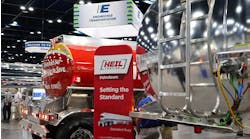New wave? FMCSA publishes eighth Intellistop exemption application
The Federal Motor Carrier Safety Administration finally is moving a little faster.
The agency took five months to publish the first round of seven exemption applications for Intellistop’s pulsating brake lamp module in the Federal Register in February 2023—and only approved the sixth one, from Encore Building Products, last month. But FMCSA posted the latest exemption request from Casey’s Services Company on Oct. 22, less than three months after it was submitted.
“They were telling me the whole process would take six to eight months, so I honestly didn’t have a lot of hope it would publish this soon,” Keith Lamfers, Casey’s transportation and distribution manager, and the Midwest region chair for National Tank Truck Carriers’ Safety and Security Council, told Bulk Transporter.
“They did say, though, this is the quickest part. Request for comments is a 30-day period, and the review and follow-up are based on the number of applications in front of us. But I hope we have an answer by early 2025, because these should be getting easier to review as they’ve set a precedent with other carriers already.”
See also: Intellistop’s pulsating rear lamp module caught in bureaucratic limbo
According to the notice, Casey’s is seeking a five-year exemption from the 49 CFR 393.25(e) requirement that all exterior lamps are steady burning, except for turn signal lamps, hazard warning signal lamps, school bus warning lamps, amber warning lamps or flashing warning lamps on tow trucks and CMVs transporting oversized loads, and warning lamps on emergency and service vehicles authorized by state or local authorities.
Casey’s asserts that using the Intellistop module, which pulses the rear clearance, identification, and brake lamps from low- to high-level lighting intensity four times in 2 seconds when the brakes are applied, rather than providing steady burning lamps during the first 2 seconds, enhances rear signal systems. Casey’s submits that pulsing the rear brake lamps of a CMV “significantly increases visibility and reduces the frequency of rear-end crashes,” and thus maintains a level of safety that is equivalent to, or greater than, the level that the CMV would achieve without the requested exemption.
The carrier’s assertion is based on real-world experience, too.
Casey’s is one of the original Intellistop supporters and now runs 150 tank trailers with the suppliers’ pulsating brake lamp technology solution. “We have seen a significant reduction in the rear-end collisions on our tanker side that we estimate has saved us in excess of a half-million dollars annually,” Lamfers said.
See also: Gemini wins first Intellistop exemption
He said he only recently sought the exemption after receiving a violation during a U.S. Dot inspection on July 26 in Iowa. “We saw Gemini and other carriers getting that exemption, so I thought well, we might as well go through the process now, so I reached out to [Intellistop president] Michelle [Hanby], and she was able to give me some guidance, and we got the application submitted.
“She’s been great throughout the whole process.”
Lamfers prefers the Intellistop module over installing auxiliary brake lamps, as allowed in Groendyke Transport’s newly renewed exemption, because it’s safer, easier to install, and requires less downtime, he contends. “The install is quick, and even if that device were to malfunction, the lights are still going to operate as normal,” he said. “Whereas, if you start splicing into wires and auxiliary lights, you risk allowing corrosion inside the wiring harness, which would cause additional issues.”
Casey’s parts and accessories exemption application received a negative comment from one anonymous poster the same day it published citing the “startle” effect on drivers that already was been debunked by multiple former FMCSA officials and law enforcement personnel Bulk Transporter interviewed over the last several years. Most recently, Nick Wright, a technical trooper with the Kansas Highway Patrol’s commercial motor vehicle enforcement division, insisted “If there’s any confusion [with a turn signal], it’s going to be resolved in half a second, because they’re going to think, ‘What’s that? Oh, OK, they’re stopping,’ or ‘OK, it’s a right-turn signal.’”
See also: FMCSA grants more pulsating brake lamp exemptions
He compared the “minimal” potential delay in response to the time drivers take to process unfamiliar signals in new locations and said the more pressing issue is passenger vehicles rear-ending tank trailers—a problem exacerbated by today’s cell phone-distracted drivers and a nearly 100-year-old, hazard-creating regulation that requires vehicles transporting hazardous materials to stop at all railroad tracks.
Furthermore, the overwhelming majority of comments on the applications FMCSA already granted—including the first one Gemini secured in May— have supported the Intellistop module. “It’s a no-brainer, so there really shouldn’t be any objections to additional exemption applications moving forward, as many carriers as FMCSA has already allowed to use it,” Lamfers said.
“It’d be very tough for the agency to deny them now.”
Lamfers is, however, expecting to receive the same installation restrictions included in previously granted exemptions, so he is not planning to equip the rest of his tank trailers or any of his dry vans until after FMCSA’s decision.
“I can’t believe Michelle hasn’t got the regulation changed already,” Lamfers said. “It surprising because automobiles have flashing lights, and motorcycles and ambulances, so all these light-duty vehicles already are using them. If it’s good enough for them, why is not good enough for the commercial vehicle industry?
“My feeling is that there will be a change in regulation. Maybe not specifically Intellistop, but a pulsating brake lamp, or something like it, in the [FMCSR] wording would allow for those devices to be used. It’s only natural that should be the next step. At some point, quit reviewing all the exemption requests and just make it a regulation.
“Intellistop makes a great product, and anything we can do to make ourselves more visible and safer out there on the roadways, so everybody goes home at the end of the day, is a good thing.”










